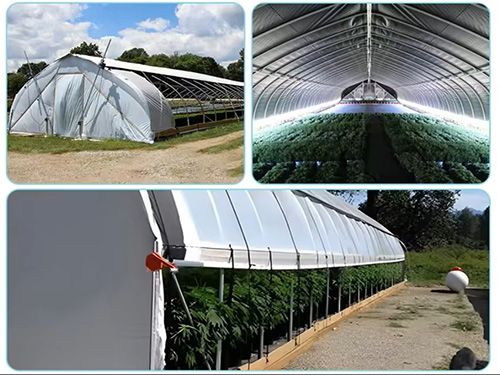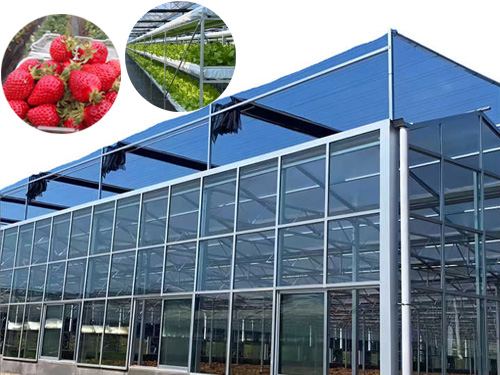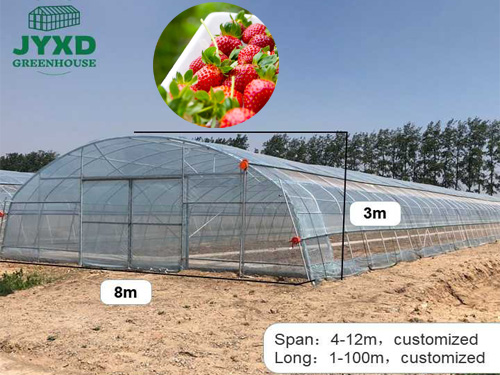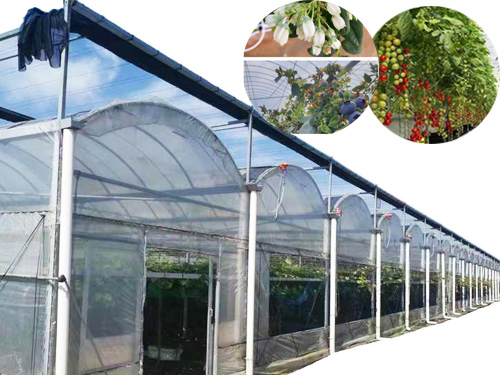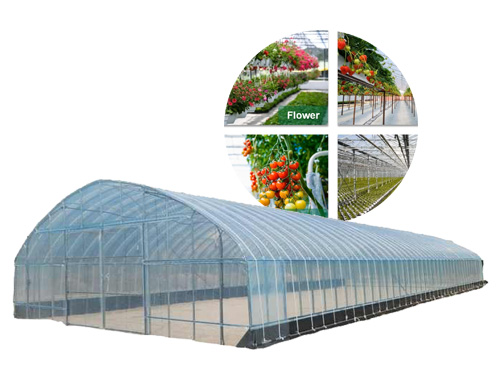NEWS DETAILS
NEWS INFORMATION
Greenhouse Environment Monitoring: Choosing the Right Sensors and Systems
AUTHOR:jyxd-greenhouse DATE:2025-01-25 23:43:03 HITS:184
In modern greenhouse farming, maintaining an optimal environment for plant growth is crucial to achieving high yields and healthy crops. One of the most effective ways to ensure this is through the use of environment monitoring systems. These systems rely on sensors to track various factors like temperature, humidity, light, CO2 levels, and soil moisture. By selecting the right sensors and systems, greenhouse operators can monitor and adjust conditions in real-time, optimizing crop growth while minimizing energy use. In this article, we will explore the importance of greenhouse environment monitoring, the types of sensors available, and how to choose the best monitoring system for your greenhouse.
The Importance of Greenhouse Environment Monitoring
Maintaining the right environment inside a greenhouse is essential for crop health and productivity. Environmental conditions, such as temperature, humidity, light, and CO2 levels, can directly influence photosynthesis, growth rates, and overall plant well-being. By using a monitoring system to track these variables, growers can make data-driven decisions to maintain ideal conditions, leading to improved crop quality and higher yields.
1. Optimal Growing Conditions
Each plant species has specific environmental needs. Some plants thrive in warm, dry conditions, while others prefer cooler, more humid environments. By continuously monitoring the greenhouse, operators can adjust factors such as temperature, humidity, and light levels to create the perfect microclimate for different crops.
2. Energy Efficiency
Efficient greenhouse management is also about reducing energy consumption. By using monitoring systems to automate temperature control, humidity regulation, and lighting, operators can reduce energy waste and lower operational costs. This is especially important as energy prices continue to rise globally.
3. Pest and Disease Prevention
Changes in environmental conditions can also influence pest and disease outbreaks. For example, higher humidity levels can encourage mold and mildew growth. By monitoring environmental factors in real-time, greenhouse operators can act quickly to correct conditions before pest and disease issues arise.
Types of Sensors for Greenhouse Monitoring
Greenhouse environment monitoring systems rely on a variety of sensors to collect data on different environmental parameters. Each type of sensor measures a specific aspect of the greenhouse environment, and understanding their function is essential when choosing the right system for your needs.
1. Temperature Sensors
Temperature is one of the most critical factors in greenhouse farming. Plants have a narrow temperature range in which they grow best, and even slight deviations can stress them, reducing yields. Temperature sensors track air and soil temperatures, ensuring that conditions remain within the optimal range.
· Air Temperature Sensors: These sensors measure the temperature of the air inside the greenhouse and can be placed at various locations to monitor temperature fluctuations.
· Soil Temperature Sensors: These sensors are used to monitor the temperature of the soil or growing medium, which directly impacts seed germination and root growth.
2. Humidity Sensors
Humidity is another essential factor in greenhouse management. High humidity can promote the growth of fungi and mold, while low humidity can cause dehydration and stress for plants. Humidity sensors measure the moisture content in the air and help operators maintain optimal levels.
· Relative Humidity (RH) Sensors: These sensors measure the amount of water vapor in the air, helping operators maintain a balance that promotes healthy plant growth.
· Dew Point Sensors: These sensors measure the temperature at which air becomes saturated with moisture, helping to predict potential condensation issues that could lead to disease outbreaks.
3. Light Sensors
Light is a vital component for photosynthesis, and different crops have different light requirements. Light sensors measure the amount of natural or artificial light entering the greenhouse, allowing operators to adjust artificial lighting as needed to ensure optimal conditions for plant growth.
· PAR Sensors: Photosynthetically Active Radiation (PAR) sensors measure the light wavelengths that plants use for photosynthesis. These sensors help determine if plants are receiving the correct spectrum of light, which is crucial for growth and development.
· Lux Meters: Lux meters measure the intensity of light in the greenhouse, helping to ensure that light levels are within the recommended range for the specific crops being grown.
4. CO2 Sensors
Carbon dioxide (CO2) is essential for photosynthesis, and greenhouse operators need to monitor CO2 levels to ensure they remain within an optimal range. Too little CO2 can limit photosynthesis, while too much can lead to excessive growth and energy inefficiency.
· CO2 Sensors: These sensors measure the concentration of CO2 in the greenhouse air. By maintaining ideal CO2 levels, greenhouse operators can optimize plant growth and increase crop yields.
5. Soil Moisture Sensors
Soil moisture is a critical factor in ensuring that plants receive the right amount of water for healthy growth. Too much water can lead to root rot, while too little can cause dehydration. Soil moisture sensors measure the water content in the soil, helping operators adjust irrigation systems to avoid overwatering or underwatering.
· Capacitive Sensors: These sensors measure the dielectric permittivity of the soil, which changes with moisture content. They provide accurate readings even in different soil types.
· Tensiometers: Tensiometers measure the tension or suction in the soil, helping determine how easily plants can absorb water from the soil.
Choosing the Right Greenhouse Environment Monitoring System
Selecting the right greenhouse environment monitoring system depends on various factors, including the size of the greenhouse, the types of crops being grown, and the specific environmental variables that need to be monitored. Here are key considerations to keep in mind when choosing a system:
1. Scalability and Flexibility
A good greenhouse monitoring system should be scalable and flexible enough to meet the evolving needs of your greenhouse. Whether you have a small-scale operation or a large commercial facility, the system should be able to handle the number of sensors required to monitor your entire growing area effectively.
2. Integration with Automation Systems
An ideal monitoring system should integrate seamlessly with other automation systems in the greenhouse, such as irrigation, ventilation, and heating systems. By connecting sensors to automated control systems, operators can adjust environmental conditions in real-time based on the data collected, making the greenhouse more efficient and responsive.
3. Data Logging and Remote Monitoring
Choose a system that allows for data logging and remote monitoring, enabling you to track environmental conditions over time and make informed decisions. Many modern greenhouse monitoring systems offer cloud-based platforms that allow you to access data from anywhere, anytime. This feature is especially useful for growers who operate multiple greenhouses or have off-site management.
4. Accuracy and Reliability
The accuracy and reliability of the sensors are crucial for effective decision-making. Low-quality or inaccurate sensors can lead to incorrect adjustments to environmental conditions, which could harm crop growth. Look for systems with high-precision sensors and ensure they are calibrated regularly for optimal performance.
5. Cost-Effectiveness
While high-end monitoring systems offer extensive features, it’s important to choose a system that fits your budget and needs. Consider the long-term benefits of investing in a quality system, such as energy savings, improved crop yields, and better resource management, which can offset the initial investment over time.
Conclusion
Greenhouse environment monitoring is an essential practice for optimizing plant growth and improving crop yields. By selecting the right sensors and systems, greenhouse operators can track and adjust environmental factors like temperature, humidity, light, CO2 levels, and soil moisture to create the perfect growing conditions. With the right monitoring system in place, growers can enhance productivity, reduce energy consumption, and ensure healthier, more profitable crops. As technology continues to advance, the role of environment monitoring in greenhouses will become even more critical in ensuring the future of sustainable agriculture.
Hebei Juyou Xinda Greenhouse Facilities Co.,Ltd.
Copyright © 2024-2025 https://www.jyxd-greenhouse.com. All Rights Reserved Hebei Juyou Xinda Greenhouse Facilities Co.,Ltd.Copyright





 Current Location:
Current Location:


